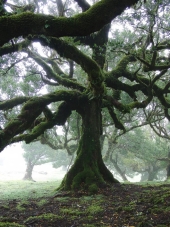I’m not into cultivating mushrooms. I used to be, but I think it’s way too labor intensive.
Instead, I’ve invested a lot of time into understanding them as an organism and how they naturally occur in ecosystems.
Basically, what it comes down to, is that if you create an environment conducive to growing mushrooms... they will grow.
You do not need to inoculate your soil, unless you’re really keen on growing a very specific species of mushroom, have been able to isolate it from anything else that may grow, and then be able to confidently identify said species within the range of possible morphological variety due to stage of maturity and climatic conditions.
Otherwise, all that you really need to do is to observe them within a permaculture system.
Permaculture gardens and food forests are great for growing mushrooms, as they tend to focus on
perennial plants and sinking a lot of wood into and onto your soil.
Most edible mushroom species prefer saprophytic conditions (complex carbohydrates in woody biomass). Some mushrooms prefer to grow on shit (coprophilic). Wine caps are one of those strange species that are defined as preferring wood, but I’ve only ever seen stropharia species growing on dung in nature. Other common edible species that occur on dung are agaricus.
But yes, so as long as you have a lot of woody matter, maybe some piles of cow or horse dung in your permaculture system, you will have mushrooms.
From my observations there are primary and secondary decomposers. Typically the coprinoids are primary decomposers, followed by others. Depending on your climatic and rain cycles, you will likely find smaller species towards the beginning of the rainy season and they will increase in size and diversity as the soil absorbs
water throughout the rainy season.
The best time to hunt for mushrooms are about a day or two after rains, when you still have high humidity.
So my suggestion for growing mushrooms would be to understand the growth parameters and climatic conditions of a specific species of mushroom that you want to grow, creating the environment for that mushroom to grow, and then observing over time.
If you get into mushroom hunting and identification, it’s quite easy to harvest spawn from the wild and transplant it into your permaculture system. Also you don’t have to spend any money and have the opportunity to learn a new skill!







